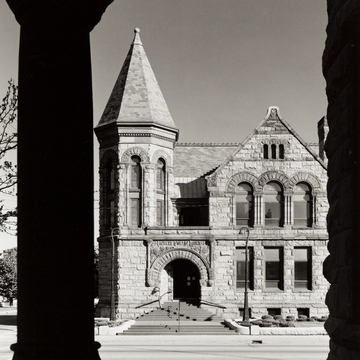Constructed of pink syenite granite with purplish-reddish brown “raindrop” Lake Superior sandstone trim, this Richardsonian Romanesque building was solidly built during the years when the supply of timber, essential to Muskegon's economy, began to fail. The library building and contents, which were Charles H. Hackley's first gift to the people of Muskegon, cost over $100,000. Hackley originally planned to spend $1,000 and donate the necessary lumber for a library, but the threats of fire convinced him that a fireproof stone building was needed. In 1899, Hackley made available $75,000 more for an addition.
The building committee selected Patton and Fisher of Chicago, famed for their schools and libraries. This design was chosen over designs submitted by five other firms, including Van Brunt and Howe, Whitney and Mundy, David S. Hopkins, Sidney J. Osgood, and Elijah E. Myers. The library is composed of gabled facades, a massive octagonal tower, and a small turret bound together in an asymmetrical but coherent mass. A wide, semicircular arch spans the main recessed entrance. The spandrels that embrace it on each side and the archivolt that defines its lower profile are all richly carved with floral motifs. Stained glass windows attributed to Millet and Burke Company of Chicago depict Shakespeare, Goethe, Longfellow, and Prescott. Patton called the style of the building “American Romanesque,” which clearly signifies that Richardsonian Romanesque was already regarded as a national style. The Hackley library owes something to H. H. Richardson's Oliver Ames Free Library (1877–1879) and Memorial Hall (1879–1881) in North Easton, Massachusetts. The interior plan here is based on a plan suggested by William F. Poole, director of the Newberry Library in Chicago and spokesman for the American Library Association movement that advocated economy and practical utility in library construction. The solidity and strength of this weighty granite library, built when it was, convey in eloquent terms the perseverance of its advocates in the face of crisis.


